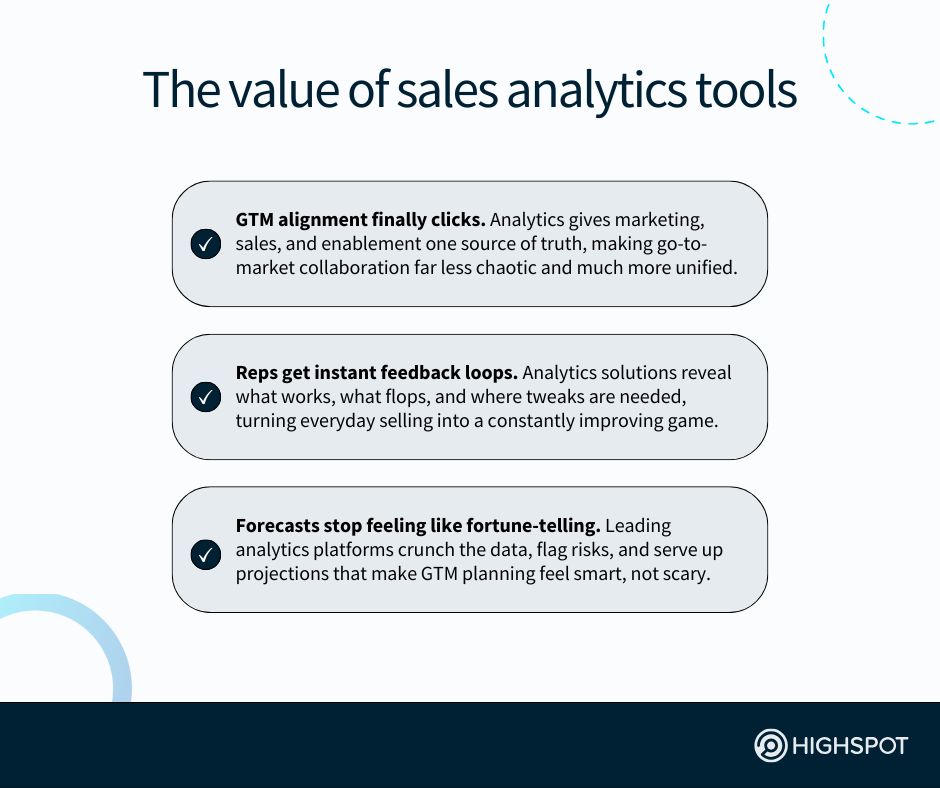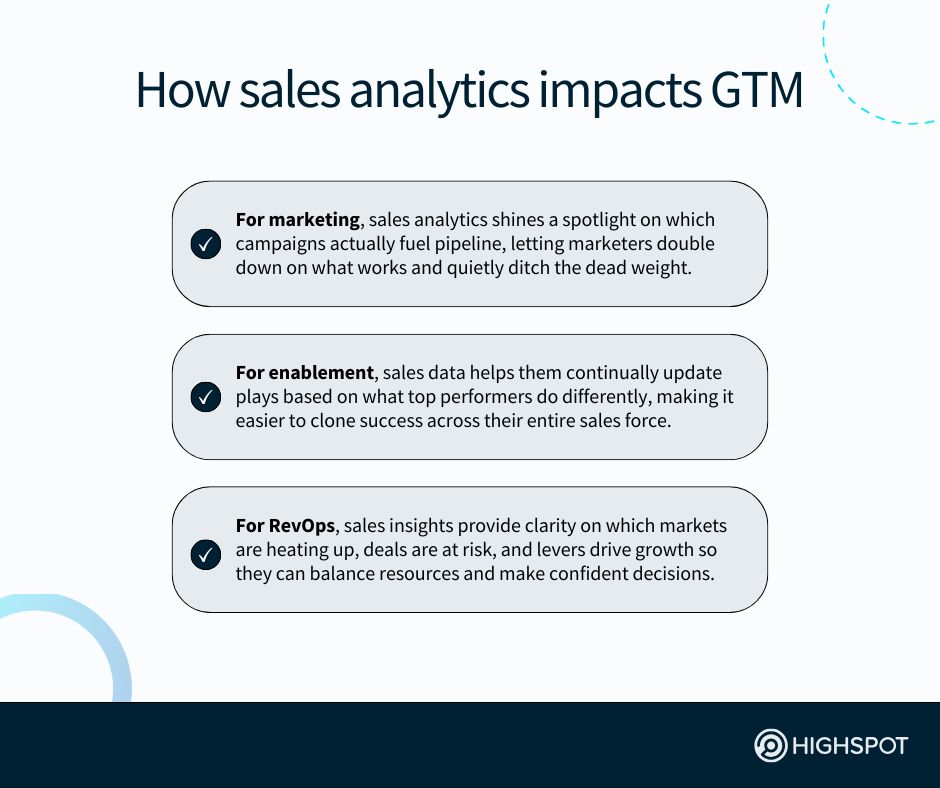Key Takeaways
- Sales analytics drives performance across three critical dimensions: productivity, proficiency, and performance—all essential for targeted enablement and stronger outcomes.
- By gathering everything from sales activity to customer behavior and leveraging predictive analytics, teams can identify trends, anticipate outcomes, and make proactive decisions.
- Look for tools that enable clear visualizations, smart forecasting, customizable KPIs, and deep integrations across your stack. Unified analytics ensure every team member can act with clarity.
Think of robust, real-time sales analytics as a way for go-to-market (GTM) teams to transform messy, disparate numbers into clear answers and actionable insights that help drive greater sales efficiency for every seller.
Instead of staring at endless spreadsheets, you can lean on cutting-edge, AI-powered sales analytics tools to unlock the kind of clarity that makes your revenue leaders smile and gives your entire sales team the confidence and conviction to act fast, pivot smartly, and stay ahead of the game to close deals.
It goes without saying that it’s no longer enough to rely on gut instinct alone.
While external data tied to market trends and competitors is valuable, you also need rich insights that reveal what’s happening inside your own walls. That means arming your sales reps with data that enhances pipeline management, pinpoints opportunities, and makes forecasting less of a guessing game.
From evaluating pipeline velocity, to assessing lead-generation activities, to anticipating customer churn, sales analytics delivers the playbook to drive revenue growth. It helps you refine strategy, sharpen execution, and, most importantly, turn prospects into paying customers without missing a beat.

What is sales analytics?
Sales analytics is the process of using data-driven insights to evaluate, optimize, and predict sales outcomes across your organization. It transforms raw data into clear visibility of revenue trends, pipeline health, and performance gaps that impact go-to-market execution.
By analyzing buyer behavior and actions and identifying historical patterns, sales analytics helps GTM leaders uncover what drives conversions and where deals stall. It combines descriptive, diagnostic, predictive, and prescriptive methods to create actionable insights that guide sales strategy execution.
Best-in-class sales analytics tools enable go-to-market teams to easily and efficiently track key sales performance metrics in real-time and with real accuracy.
With robust dashboards in these solutions, GTM leaders, in particular, can visualize performance in real time and quickly adapt to shifting market conditions or buyer needs.
Ultimately, analytics helps sales, marketing, and revenue leaders to get the valuable insights they need to empower their reps to sell smarter, accelerate business growth, and make confident decisions grounded in reliable data and evidence.
Types of sales analytics
There is certainly no shortage of key sales metrics to monitor using sales analytics tools that blend conversation intelligence and customer engagement data tied to recent deals and historical data for closed-won and -lost opportunities to provide a comprehensive view of go-to-market performance.
The most popular kinds of sales performance data GTM leaders at B2B organizations track regularly include:
| Type of sales analytics | How it helps GTM teams |
|---|---|
| Descriptive analytics | Descriptive analytics reviews past sales data to explain what happened. It summarizes performance—like revenue, cycle length, or quota attainment—and sets baselines. It answers questions such as, “How much did we sell last quarter?” or “Which regions delivered the most?” |
| Diagnostic analytics | Diagnostic analytics uncovers why performance trends occurred. It identifies causes such as weaker lead quality, longer deal cycles, or poor messaging. This kind of analytics helps GTM leaders spot bottlenecks and correct issues before they impact upcoming results. |
| Predictive analytics | Predictive analytics uses AI and machine learning to forecast sales outcomes. It notes which deals are most likely to close, which accounts have the most value, and where revenue could come from. By spotting trends, you anticipate needs and prioritize high-value opportunities. |
| Prescriptive analytics | Prescriptive analytics recommends next steps for GTM teams. For example, it may suggest prospecting tactics that drive strong results for reps or the pricing model most effective in a given territory for revenue leaders. It models different scenarios to guide smarter sales decisions. |
| Pipeline analytics | Pipeline analytics tracks the health of deals moving through your sales funnel. It shows volume, conversion rates, and velocity to pinpoint exactly where opportunities stall. This visibility helps GTM leaders manage risk, balance the pipeline, and keep growth on track. |
| Win-loss analytics | Win-loss analytics reveals why opportunities succeed or fail. Reviewing lost deals uncovers gaps like weak brand positioning, while analyzing wins unearths what content resonates with buyers. The result is better messaging, sharper strategy, and stronger deal execution. |
| Forecasting analytics | Forecasting analytics blends historical data, pipeline info, and market inputs to project future revenue. Accurate forecasts guide planning, hiring, and resource allocation. Modern forecasting pairs rep judgment with predictive models to improve reliability and account for change. |
| Customer analytics | Customer analytics examines buying behavior, engagement, and long-term value. It segments accounts by history, size, or churn risk, helping you find upsell and cross-sell opportunities. It ensures sales efforts focus on the customers and segments with the highest potential. |
| Performance analytics | Performance analytics measures how reps, teams, and regions perform against various KPIs, including quota, deal size, win rate, and cycle time. It reveals best practices, skill gaps, and coaching opportunities, helping GTM leaders motivate teams and improve productivity. |
| Market and territory analytics | Market and territory analytics evaluates how well sales teams cover markets and territories. It analyzes account distribution, territory potential, and competitive presence. The insights guide resource allocation, improve balance, and uncover new segments for expansion. |
10 components of modern sales analytics
Predicting sales trends and getting accurate sales forecasts are crucial tasks every GTM leader must undertake today. But before you can scrutinize your deal data to accelerate sales growth, you must first put the analytics foundation in place.
Here are the steps you must take to build an effective sales analytics environment that can ultimately help you boost sales team performance and results.
1. Data collection
Think of data collection as scooping up every breadcrumb your sellers leave behind. Every click, call, and customer convo matters, and this is where it all begins.
Pulling information from your CRM system, email threads, calls with prospects, and even internal meeting notes creates the raw fuel for actionable insights.
With solid data collection habits, you can monitor sales trends without second-guessing. It’s the gathering stage where curiosity rules and nothing gets left behind, giving your GTM leaders the building blocks they’ll need later.
2. Data integration
Next, you mix the ingredients. Data integration makes all those scattered sources—structured data from marketing tools and finance systems and unstructured notes from each sales representative on your team—play nice together.
The magic happens when you integrate seamlessly so different platforms in your sales technology stack so all solutions can share data with one another. Instead of toggling across tabs, you get one unified, centralized view.
Think of it like a single playlist pulling songs from every genre. You get a holistic, 360-degree view of your sales and marketing strategies.
Short term, you can use this data from across your marketing and sales organizations to ensure reps have stronger customer interactions and close deals more efficiently. Long term, you can better predict future sales and boost revenue.
3. Data cleaning
Nobody likes messy data. It’s like trying to sell with spinach in your teeth.
Data cleaning scrubs the grime, fixes typos, and ensures accuracy so your sales process doesn’t trip over bad inputs. This step transforms chaos into clarity, setting you up to identify patterns without worrying if the numbers are lying.
It’s not glamorous, but without it, your analysis of sales department performance would be built on shaky ground. Clean data means smooth insights and smarter moves that help accelerate pipeline velocity and sales growth.
4. Data storage
Picture data storage as the cozy library where all your historical sales data goes to rest. Neatly stacked, perfectly indexed, and ready for instant checkout.
Whether it’s a warehouse in the cloud or a private vault, this is where order replaces clutter. Good storage makes pulling insights simple, and lets sales operations teams keep everything secure and scalable.
Without a centralized system where you can comb over past sales performance data, your team is just hoarding sticky notes. With it, sales leaders get real clarity.
5. Data visualization
Data visualization flips bland numbers into bright, digestible stories.
Charts, heat maps, and graphs suddenly spotlight key performance indicators that might’ve stayed hidden. This is also where you set up sales dashboards that feel less like spreadsheets and more like scoreboards for your sales reps.
The top sales analytics software offers intuitive, easy-to-navigate dashboards that help marketing directors, revenue leaders, and sales managers review historical data tied to lead and customer data in a visually compelling manner.
6. Data analysis
Welcome to the detective work of sales analytics: data analysis. Here, you poke, prod, and piece together the clues hidden in past sales performance.
Want to know what works, what flopped, or why last quarter soared? This is your playground where you can dive deep into what’s helping or hurting your efforts to hit sales targets and drive down your average sales cycle length.
You uncover the key factors that influence deals, and turn those lightbulb moments into next steps. It’s equal parts intuition and math class, but with the thrill of discovering what every sales professional needs to win more often.
7. Predictive modeling
Now, you’re looking into the crystal ball.
Predictive modeling crunches the numbers to forecast future revenue with uncanny precision. It tells you what happened and whispers what’s next, whether that’s a hot deal about to close or a sales pipeline drought on the horizon.
Essential for effective business planning and forecasting, this is where data science meets sales intuition. With the right models, you’re no longer guessing. You’re also charting the most strategic path forward with confidence.
8. Insight generation
This is where insights stop being abstract and become, well, actionable insights. It’s taking the numbers, graphs, and projections and spinning them into clear recommendations your sales representatives can actually use.
Maybe it’s a nudge to tweak messaging, or proof a pricing strategy works. Insight generation transforms math into meaning, giving GTM teams fuel for smarter decisions. It’s not just knowing the “what” or the “why,” but knowing the “what now.”
9. Action and optimization
Testing ideas, refining approaches, and chasing better outcomes in real-time helps you and other sales leaders experiment, compare reps’ sales performance, and double down on what clicks so you can increase total sales revenue.
Maybe you try a new pitch, or lean on a sales enablement platform like Highspot for stronger messaging. Optimization isn’t a one-and-done activity. It’s the habit of never settling and always sharpening sales reps’ skills.
This is how sellers—BDRs, account executives, and field sales teams—turn go-to-market strategies into near-term wins and repeatable playbooks in the long run.
10. Sales performance monitoring
Performance monitoring ties it all together. Sales rep scorecards enable managers, in particular, to better track buyer engagement and outcomes, measure sales representatives’ success, and adjust course quickly.
By continuously watching how go-to-market plays and initiatives unfold, you stay agile, confident, and ready to pivot whenever needed to keep growth humming.

The biggest benefits of sales analytics
Sales intelligence simplifies the complex in your end-to-end GTM efforts. It makes it easier for your entire sales team to make sense of the challenges and roadblocks of the sales process and find the best ways to overcome them.
Leveraging sales analytics provides several benefits, such as:
- Improved sales performance: Sales analytics empowers organizations to pinpoint their best-performing sales tactics and allocate resources more efficiently. By identifying successful sales strategies, teams can focus on high-impact activities that drive revenue.
- Enhanced customer understanding: Understanding customer behavior is crucial for any business. Sales analytics provides valuable insights into customer preferences, pain points, and buying habits, allowing organizations to tailor their sales messaging.
- Optimized sales funnel: With sales analytics, businesses can optimize their sales pipeline by identifying bottlenecks and areas for improvement. This leads to better lead conversion rates and a more streamlined sales process.
- Real-time decision-making: Sales analytics enables real-time data monitoring, allowing businesses to react promptly to market changes, customer demands, and emerging opportunities. These actionable insights are essential for staying ahead in a competitive landscape.
As Highspot’s GTM Performance Gap Report explains, the most successful B2B organizations use best-in-class sales analytics tools to close the go-to-market performance gap and ensure their enablement, marketing, and sales teams work as one cohesive unit working toward the same North Star goals.
“They govern execution as a business discipline, not a reactive function,” per the report. “They define success in outcome-led terms. They align early, assign shared ownership, and reinforce strategy through a consistent operating rhythm across content, coaching, analytics, and frontline action.”
| Sales analytics metric | What it measures | Sales metric formula |
|---|---|---|
| Revenue growth | How fast sales revenue grows, showing business health and momentum | (Current revenue – Previous revenue) ÷ Previous revenue × 100 |
| Sales cycle length | How long deals take to close, revealing efficiency and friction points | Average number of days from first contact to close |
| Win rate | Percentage of won deals versus opportunities, highlighting sales effectiveness | (Number of closed-won deals ÷ Total opportunities) × 100 |
| Quota attainment | How much of their sales target each rep achieves, showing productivity | (Actual sales ÷ Sales quota) × 100 |
| Pipeline coverage | If pipeline value is large enough to hit revenue goals | Total pipeline value ÷ Revenue target |
| Customer acquisition costs (CAC) | Cost to acquire new customers, indicating efficiency of spend | {Total sales and marketing costs} ÷ {Number of new customers acquired} |
| Customer lifetime value (CLV) | Total revenue a customer generates, aligning spend with payoff | Average purchase value × Purchase frequency × Customer lifespan |
| Average deal size | Average value of closed deals, informing pricing and targeting strategies | Total revenue from closed deals ÷ Number of closed deals |
| Sales velocity | How quickly revenue flows through pipeline, reflecting sales efficiency | (Number of opportunities × Average deal size × Win rate) ÷ Sales cycle length |
| Lead conversion rate | How many leads become qualified opportunities, proving lead quality | (Qualified leads ÷ Total leads) × 100 |
| Opportunity-to-win ratio | How many qualified opportunities close, revealing sales effectiveness | (Closed-won deals ÷ Qualified opportunities) × 100 |
| Cost of selling | Sales expenses per deal, exposing efficiency and margin impact | Total sales expenses ÷ Number of deals closed |
| Rep ramp time | Time for new reps to reach full productivity, affecting revenue plans | Average time for new rep to achieve quota |
| Lead response time | How quickly reps follow up with leads, impacting conversion chances | Average time between lead creation and first rep contact |
| Forecast accuracy | Projected revenue to actuals, testing reliability of forecasts | (1 – |Forecasted revenue – Actual revenue| ÷ Actual revenue) × 100 |
Your sales analytics questions, answered
You clearly know the value of sales tools with analytics to your GTM success.
But we also know there are nuances to leveraging your data to speed up your sales cycle, strengthen your overall sales strategy, and further empower sales reps.
Thankfully, we’ve got some answers to your FAQs.
Which sales analytics tools does my team need to succeed?
You need solutions that track pipeline health, forecast accuracy, win rates, and rep activity. The best sales analytics tools unify data, visualize trends in real-time, and generate actionable insights. With the right platforms, your GTM leaders can improve decision-making, rep coaching, and sales execution.
What should my team look for in sales analytics software?
Look for software that integrates seamlessly with your CRM, scales as your pipeline grows, and provides clear dashboards. Strong systems deliver predictive insights, automate reporting, and support sales enablement. Prioritize usability and advanced analytics so everyone in GTM benefits from the tech daily.
Can we easily add analytics tools to our sales environment?
Yes, many leading sales analytic tools sync directly with CRMs and other GTM technologies. Setup is typically straightforward, requiring only light configuration. Choosing unified platforms ensures you can share data with one another, streamline reporting, and use insights quickly without disrupting workflows.
How can I take action on my sales team’s performance data?
Start by identifying KPIs tied to sales goals. Use dashboards to compare reps’ sales performance, spot coaching opportunities, and refine strategy. Turn insights into clear steps—adjust territories, optimize messaging, or rebalance activity—to ensure your team consistently meets targets and accelerates revenue growth.
Should I use analytics to inform our sales goals and targets?
Yes, analytics are essential for effective business planning and forecasting. By analyzing past sales performance, you identify trends and patterns that improve target setting. Data-driven sales goals are realistic, motivating, and aligned with GTM strategy, ensuring you balance ambition with achievable execution.
What are best practices for gauging sales success with data?
Track a blend of activity and outcome metrics like win rate, pipeline coverage, and average deal size. Benchmark against past sales performance to measure improvement. Use dashboards to monitor sales trends and adjust GTM tactics, ensuring analysis links directly to revenue outcomes and productivity gains.
How can I use predictive sales forecast data to improve GTM?
Predictive forecasts reveal key factors that influence deal closure and revenue trends. By anticipating risks and opportunities, you can adjust your sales process, better allocate resources, and optimize territories. This foresight can give you the data-backed confidence to act with precision and reduce uncertainty.
Which analytics skills do B2B sales professionals need today?
Reps need skills in interpreting sales data, setting up dashboards, and connecting insights to strategy. Familiarity with forecasting, pipeline health metrics, and automation is crucial. Strong communication is equally critical, ensuring insights translate into actions that drive sales goals and team alignment.
How can I streamline sales analysis using AI and automation?
Artificial intelligence accelerates sales analysis by systematically cleaning data, surfacing patterns, and generating real-time insights. Automation reduces manual reporting and improves forecast accuracy. With AI sales assistants, your leaders free up time for strategic planning and avoid getting stuck with admin work.
What are some key best practices for interpreting sales data?
Begin with clean, accurate data stored in one unified, centralized system. Focus analysis on key performance indicators and align them with sales goals. Use visual dashboards to simplify complex results and identify patterns quickly. Finally, translate findings into clear actions for sellers to execute confidently.
Can sales analytics improve customer retention and churn?
Yes, analytics can unearth churn risks by tracking engagement, product usage, and contract renewals. Spotting warning signs early can help your customer success team be proactive with tailored outreach and upsell strategies. This data-driven approach helps retain high-value customers and ensures revenue stability.




